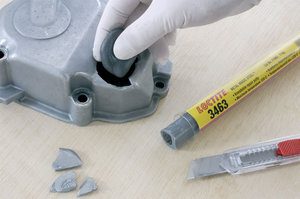
P043F Evap Leak Detection Reference Orifice High
Content
- P043F Evap Leak Detection Reference Orifice High
- OBD-II DTC Datasheet
- What does this mean?
- What is the severity of this DTC?
- What are some of the symptoms of the code?
- What are some of the common causes for the code?
- What are some steps to troubleshoot the P043F?
- Related DTC discussions
- Need more help with your P043F code?
P043F Evap Leak Detection Reference Orifice High
OBD-II DTC Datasheet
Evaporative Emission System Leak Detection Reference Orifice High Flow
What does this mean?
This is a generic diagnostic trouble code (DTC) that is commonly applied to OBD-II vehicles that have an EVAP system that uses a leak detection system. This could include but is not limited to Toyota, Scion, GM, Chevrolet, Hyundai, Pontiac, Volvo, etc. According to some reports, this code seems to be much more common on Toyota vehicles. Although general, the exact repair steps may vary depending on the model year, make, model, and transmission configuration.
The PCM has detected a discrepancy in the evaporative emissions system (EVAP) leak detection reference orifice when a code P043F is stored in your OBD-II vehicle. In this case, a high flow condition has been indicated.
The EVAP system is designed to trap fuel vapors (from the fuel tank) before they are released into the atmosphere. The EVAP system uses a vented reservoir (commonly referred to as a canister) to store excess vapors until the engine is operating under the appropriate conditions to burn it most efficiently.
The pressure (generated by storing the fuel) acts like a propellant, forcing the vapors to escape through the tubes and eventually into the canister. The carbon element contained in the canister absorbs fuel vapors and holds them for release at the right time.
Various sample ports, a leak detection pump, a charcoal canister, an EVAP pressure gauge, a purge valve / solenoid, an exhaust control valve / solenoid, and an intricate system of metal pipes and rubber hoses (extending from the fuel tank to the engine bay) are typical components of the EVAP system.
The engine vacuum is used by the EVAP system to pull fuel vapors (from the coal tank and through the lines) into the intake manifold, where they can be burned rather than vented. The PCM electronically controls the purge valve / solenoid, which is the gateway of the EVAP system. It is responsible for regulating the vacuum at the inlet to the EVAP canister so that fuel vapors can only be drawn into the engine when conditions are ideal for most efficient combustion of the fuel pressure vapor.
Some EVAP systems use an electronic leak detection pump to pressurize the system so that the system can be checked for leaks / flow. Leak detection reference holes can be placed at either one point or multiple points throughout the EVAP system. Leak detection reference ports are usually linear so that flow can be accurately measured when the leak detection pump is activated. The PCM uses inputs from the EVAP pressure and flow sensors in conjunction with the reference port / ports for leak detection to determine if the leak detection system is working properly. The EVAP Leak Detection Reference Port can be a small filter type device, or simply a section of the EVAP line that restricts flow so that the EVAP pressure / flow sensor can obtain an accurate sample.
If the PCM detects a high flow condition through the EVAP leak detection reference orifice, a code P043F will be stored and a malfunction indicator lamp (MIL) may be illuminated.
What is the severity of this DTC?
EVAP leak detection codes, similar to the P043F, deal exclusively with the evaporative emission control system and should not be classified as severe.
What are some of the symptoms of the code?
Symptoms of a P043F trouble code may include:
- No symptoms will likely be exhibited
- Hissing or humming sound (even when the ignition switch OFF)
- Slightly reduced fuel efficiency
- Other EVAP leak detection codes may be stored
What are some of the common causes for the code?
Reasons for this P043F engine code may include:
- Faulty EVAP pressure sensor
- Defective ventilation or purge control solenoid
- Defective leak detection pump
What are some steps to troubleshoot the P043F?
A diagnostic scanner, a digital volt/ohmmeter (DVOM), and a reliable vehicle information source will prove necessary for diagnosing a code P043F.
Use your vehicle information source to check technical service bulletins (TSBs) that match the symptoms and codes presented in the vehicle being diagnosed. If you can find the appropriate TSB, it will most likely guide you to the exact source of the problem without spending a lot of time and effort.
If there are other EVAP system codes present, diagnose and repair these before attempting to diagnose the P043F. The P043F could be in reaction to the conditions which have caused other EVAP codes.
Before getting your hands dirty, connect the scanner to the vehicle's diagnostic port and retrieve all stored codes and freeze frame data. I like to write this information down as it can be helpful as my diagnosis progresses. Once you've done this, clear the codes and test drive the vehicle to make sure the code is cleared.
Ideally, you’d like to test-drive the vehicle until one of two things occurs; the PCM enters readiness mode or the code is reset. If the PCM enters readiness mode, you have an intermittent problem (or you have repaired it inadvertently) and there’s not a lot that you can do about it now. If it returns later, the failure condition may have worsened and you can take another run at it. If the P043F is reset, you know that you have a hard-and-fast malfunction and it’s time to dig in and find it.
Start by visually inspecting all EVAP system wiring and connectors that you can access within a reasonable time frame. Obviously, you are not going to remove any major components to view, but rather focus your efforts on high temperature areas and areas where wiring, connectors, vacuum lines, and steam hoses can interfere with moving components. Many cars get repaired during this stage of the diagnostic process, so focus and put in a little effort.
Connect the scanner to the vehicle diagnostic port and observe the data flow. EVAP flow and pressure data must comply with manufacturer's specifications when the system is activated. In most cases, activation of the EVAP system (purge solenoid valve and / or leak detection pump) can be performed using the scanner. Some EVAP sensor testing will need to be performed with the system activated.
Use the DVOM to test EVAP sensors and solenoids in order to compare them with manufacturer’s specifications. Any related components that do not coincide with specifications will need to be replaced. If possible, gain access to the EVAP leak detection reference orifice to check for charcoal contamination. If charcoal contamination is found, suspect that the EVAP canister has been compromised.
Before testing system circuits with DVOM, disconnect all associated controllers to prevent damage. Check the appropriate resistance and continuity levels between the individual EVAP and PCM components using the DVOM. Chains that do not meet specifications need to be repaired or replaced.
- A loose or failed fuel cap will not cause a code P043F to be stored
- This code only applies to automotive EVAP systems that use a leak detection system.
Related DTC discussions
- 05 Corolla P2419, P2402, P2401, P043F, P043EHello everyone This is my first time on such a forum. So it looks like I'm in trouble with my Corolla. It has driven over 300,000 km and seems to be working fine. The engine lamp came on, I checked the codes and got the following codes: P2419, P2402, P2401, P043F, P043E Everything is connected with the evaporator ...
- 2007 toyota corolla codes p043f p2419 p2402 p2401 p0456i am getting codes p0456, p043f, p2401, p2402, p2419 2007 toyota corolla with 160,000 miles. what is causing these codes….
Need more help with your P043F code?
If you still need help with the P043F error code, post a question in the comments below this article.
NOTE. This information is provided for informational purposes only. It is not intended to be used as a repair recommendation and we are not responsible for any action you take on any vehicle. All information on this site is protected by copyright.

